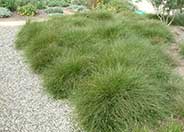
Common name:Sea Lavender, Statice
Botanical name:Limonium perezii
This mounding shrub will reach about 3' high and has large, dark green leaves with small blue and purple flowers that bloom in spring and summer.

Common name:Mexican Bush Sage
Botanical name:Salvia leucantha
The Mexican Sage is a bushy shrub that grows 3'-4' tall and wide. It has hairy white stems, gray green leaves and velvet-like purple flower spikes that bloom summer through fall. This shrub tolerates sun, light shade, little water, and is hardy to 15 degrees F. The Mexican Sage is drought tolerant and attracts hummingbirds.

Common name:Curly Top Sedge
Botanical name:Carex buchananii
This orange bronze ornamental grass/reed is 2'-3' tall and 1'-2' wide and does best in full sun to part shade.

Common name:Ferned-Leaved Tickseed
Botanical name:Bidens ferulifolia 'Goldmarie'
Tickseed grows 14'-18" tall. It is a heat tolerant variety that is perfect for cascading, bright color in baskets, containers, and window boxes. Finely divided foliage is covered with gold, single flowers. It blooms until first frost. Plant in full sun. It needs well-drained soi.

Common name:Kangaroo Paw 'Yellow'
Botanical name:Anigozanthos 'Yellow'
This herbaceous perennial can reach 4'-6' tall and 2'-3' wide. Kangaroo Paw has strap-like leaves and fuzzy tubular-shaped, yellow flowers that bloom in spring and fade as summer progresses. They can be used for cut or dried flowers. The flowers have nectar which attract hummingbirds. Kangaroo Paw does well in full sun and looks great in borders, mass plantings, and in pots. It can do well in drought tolerant conditions. It prefers sandy soil and deep, infrequent watering.

Common name:Coast Live Oak
Botanical name:Quercus agrifolia
Coast Live Oak (Quercus agrifolia) is one of the best trees for California native or California-friendly gardens. It grows very well from the coastal areas to the interior valleys. It is an evergreen tree that can reach 25’-70' tall and up to 70' wide, so make sure you have the space in your garden to support it. It is considered very low-water-use and is susceptible to root rot in gardens that are over-irrigated. Plant it with other California natives or low-water plants and stick to a watering cycle that includes watering during the fall, winter, and spring with no supplemental water in the summer. The tree is a slow grower and has an irregular shape when it is young, so it is important to make minimal pruning cuts to improve the look of the canopy. Over-pruning or hedging can take years to recover from, so consult or hire a licensed arborist when the shaping becomes out of your reach. This tree will eventually become a large shade tree; therefore, the plant selection around it may need to be adjusted as it matures. This tree should be planted at least five feet away from any hardscape areas, 20 feet from structures such as houses and buildings, and not near any powerlines. Shrubs and perennials should be planted about four feet away from this tree. It should be irrigated for about 45 minutes once a week when using most in-line drip irrigation systems.

Common name:Toyon
Botanical name:Heteromeles arbutifolia
Toyon is a California native evergreen shrub that grows 8'-15' high and spreading 2'-3'. It has leathery toothed leaves, white summer flowers and clusters of red winter berries. It tolerates full sun or partial shade, heat, smog, wind and heavy or light soils. It is drought tolerant, attracts beneficial insects and hummingbirds.

Common name:Clustered Field Sedge
Botanical name:Carex praegracilis
Clustered Field Sedge (Carex praegracilis) is a species in the Cyperaceae (Sedge) family. It is native to much of North America, from Alaska across southern Canada and throughout the continental United States, except for the southeastern region.
It grows in wet and seasonally wet environments in a number of habitats, including meadows and wetlands; it is often riparian or semi-riparian in the drier parts of its range. It tolerates disturbed habitat such as roadsides and thrives in alkaline substrates.
Designer: Daley Landscape
Photographer: GardenSoft
Maintain a two to four inch layer of mulch on the soil surface to reduce weeds, infiltrate rain water, and reduce compaction.
Drip and other smart irrigation delivers water directly to roots, allowing no excess water for weeds.